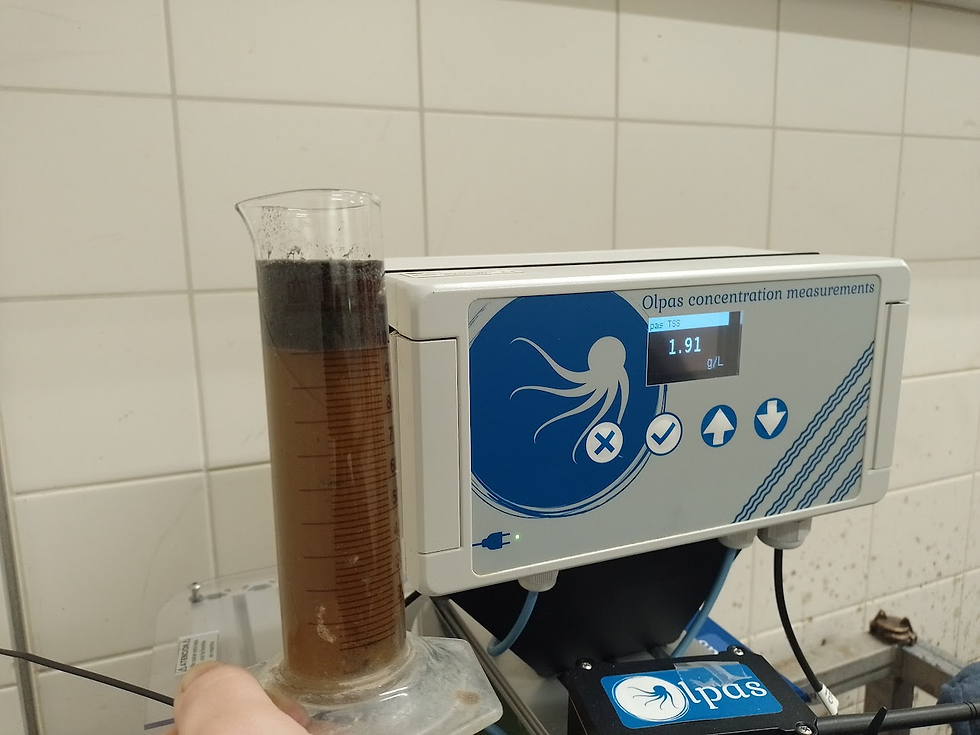Centrate/filtrate monitoring as feedback control
- Jo Wouters

- Jul 13, 2025
- 3 min read
Recap: Back to feed-forward
Previously we discussed the possibilities of feed-forward control in sludge dewatering based on the Olpas sludge concentration sensor - measuring the sludge Total Solids (%TS in g/L) that goes into the dewatering process (sludge inlet concentration). It allows to scale the sludge flowrate in the dewatering system and the amount of polyelectrolyte content on the measured sludge concentration. This allows for accurate dosing in real time in dewatering plants.
Although valuable as a control mechanism, feed-forward control is not sufficient for a complete optimization in complex situations. For example, sludge concentration sensors measure the Total Solids (%TS) concentration, but do not distinguish between organic or inorganic content in sludge. Wastewater treatment plants with high variability in organic/inorganic ratio or sludge morphology might benefit from feedback control based on centrate/filtrate concentration measurements.
A feedback control system based on centrate or fitrate concentrations allows for compensating any errors in the forward control of the dewatering plant. Such errors arrise due to changing properties of sludge, polyelectrolyte and/or equipment such as pumps and flowmeters.
Total Suspended Solids (TSS) in centrate/filtrate
Invaluable is the measurement of Total Suspended Solids (TSS) in centrate or filtrate. The residual amount of suspended solids is a direct indicator of the efficiency or performance of a dewatering process. A dirty centrate or filtrate is indicative of suboptimal dewatering. It allows to indicate issues in the feed-forward control of polyelectrolyte dosing.
For decanter centrifuges the underdosing of polyelectrolye is almost always directly visible in the increase of TSS content in centrate. For screw presses and other dewatering equipment this is true as well, however, the effect of overdosage can be more detrimental for those systems. Overdosage increases the polyelectrolyte supply in a water mixture, leading to a net decrease in dewatering efficiency. Typically, overdosing for decanter centrifuges leads to large flocs suspended in the centrate flow.
As particle size of the suspended solids can vary greatly, from micrometer sized sludge particles up to almost millimeter sized flocs, a measurement system with a large particle size sensitivity needs to be employed. Luckily, Olpas ultrasound technology based on ultrasound back-scattering is equally responsive to particles in a large spread of diameters.

Residual PE: detecting PE overdosage
Total Suspended Solids measurements are a strong indicative parameter of PE underdosing. Overdosage of PE is more difficult to detect based on TSS concentration. In general, only strong PE overdosage increase centrate or filtrate TSS, leading to difficulties in optimization of the sludge dewatering process based on feedback control on TSS only.
For this reason, Olpas developed the measurement of residual PE in centrate and filtrate. The residual polymer concentration, often in the range of 0-100 mg/L, responds quickly to overdosage events or a mismatch in PE type or efficiency.
The measurement of PE content is mostly relevant at low TSS content or when large TSS flocs are present - when overdosing can be expected. In those conditions the centrate solids content is not representative of the dewatering efficiency as a whole. PE resdiual concentrations highlight the possible overdosing that occurs and allow operators or automatic control systems to finetune PE content more reliably.
Olpas centrate/filtrate measurement solution
Olpas developed an end-to-end solution for easy and accurate measurement of centrate residuals. The measurement solution features a peristaltic pump for centrate sampling. The ultrasound concentration sensor is installed in a flowcell able to deal with large deposits and suspended air bubbles. The flowcell is flushed automatically allowing to operate the set-up with minimal maintenance (monthly cleaning). The setup measures TSS and residual PE in centrate independent of air bubble content.

Olpas TSS/PE measurement in flowcell with peristaltic pump sampler and automatic flushing
The typical blockage formation of solids in centrate or filtrate due to further contact with unbound PE is completely avoided due to the automatic flushing routine of both inlet, outlet and flowcell. For this reason the measurement system is quasi maintenance free and allows for 24/7 control of dewatering plants.
Conclusion: Feedback control of dewatering based on Total Suspended Solids (TSS) and Polyelectrolyte (PE) concentration

A standard approach to sludge dewatering optimization uses the Olpas sludge concentration as the input for feedforward control parameters for PE dosing. By doing so, a fast responsive system can be setup that accurately changes PE supply rates to sludge dewatering plants in real-time.
To complement this optimization, a feedback control based on the residuals in centrate or filtrate is proposed. The TSS concentration is indicative for the efficiency of the dewatering process and the residual PE concentration highlights any overdosage event accurately.
Feedforward control using sludge concentration and feedback via centrate/filtrate Total Suspended Solids and Polyelektrolyte (PE) concentration allows for a full, automatic control and optimisation of any dewatering installation.


